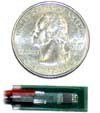Type 1 Temperature Sensors
P/N
236-800-XX
 |
 |
Georgia Controls Type 1 Temperature Sensors are small 0.300 x 0.925" (7.62 x 23.5mm) circuit boards with temperature measuring electronic components mounted on them. Each tiny sensor has two 6" (15.2cm) wires attached for connection to a wire harness or termination into a connector. These sensors can be electrically up to 100 feet (30m) away from Georgia Controls Type 1 compatible devices. Multiple sensors can be wired in parallel on a single harness to create a sensor network. Type 1 temperature sensors are high temperature epoxy encapsulated on the circuit side for corrosion resistance and to aid with ESD protection. The bottom of the board is the thermal pad, and quickly conducts heat to the temperature sensor on the top of the circuit board.
There are some advantages from Georgia Controls Type 1 Temperature Sensors being circuit boards which are not mounted inside a housing. Mounting options are increased and mass is decreased. A lower mass decreases thermal response time (makes it faster). Mounting options for Type 1 temperature sensors include:
- Directly to a freon line
- Directly to a water pipe
- In free air
For quickest response and increased accuracy, these sensors should be mounted with a thin layer of thermally conductive grease between the gold heat pad and the device being measured. Another trick is to have the sensor and about 5" of wire in contact with the device being measured and insulated to avoid ambient room temperatures from slowing temperature readings.
Type 1 temperature sensors use Maxim (Dallas) 1-Wire devices and may be used with non-Georgia Controls products which are 1-Wire compatible. Contact Georgia Controls with compatibilty questions.
Specifications:
- Powered through the data line
- Power supply range of 3.0V to 5.5V
- Measures temperatures from -55°C to +125°C (-67°F to +257°F)
- ±0.5°C accuracy from -10°C to +85°C
- Sensor resolution is user selectable from 9 to 12 Bits (Georgia Controls devices that use Type 1 temperature sensors typically use 12 bits)
- Converts in 750ms (max)
|
About Georgia Controls Family Codes Since all these sensors are the same physically, they are installed in networks, and they are located in different places inside a piece of equipment, Type 1 temperature sensors are programmed with a "Family Code." The family codes tell Georgia Controls devices "where" the sensor is installed, or in other words, "what" the sensor is measuring. For example, when a Georgia Controls motherboard reads a group of these sensors on a two-wire network, and it sees a sensor with a family code of 26, it knows that sensor is reading loop heat exchanger temperature and to use that particular sensor for the FreezeCop function. Each family code represents a separate place to monitor the temperature. |

